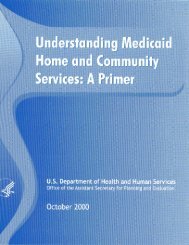STRATEGIC PLAN - ASPE - U.S. Department of Health and Human ...
STRATEGIC PLAN - ASPE - U.S. Department of Health and Human ...
STRATEGIC PLAN - ASPE - U.S. Department of Health and Human ...
You also want an ePaper? Increase the reach of your titles
YUMPU automatically turns print PDFs into web optimized ePapers that Google loves.
CHAPTER 2: <strong>Health</strong> careReducing <strong>Health</strong> DisparitiesThe United States health care delivery systemencompasses outst<strong>and</strong>ing providers, facilities, <strong>and</strong>technology. Many Americans enjoy easy access to care.However, not all Americans have full access to highqualityhealth care.The National <strong>Health</strong>care Disparities Report (2006Disparities Report), published annually by the Agencyfor <strong>Health</strong>care Research <strong>and</strong> Quality (AHRQ), providesa comprehensive national overview <strong>of</strong> disparities inhealth care in America <strong>and</strong> tracks the Nation’s progresstoward the elimination <strong>of</strong> health care disparities. xviMeasures <strong>of</strong> health care access are unique to this report<strong>and</strong> encompass two dimensions <strong>of</strong> access: facilitators<strong>and</strong> barriers to care, <strong>and</strong> health care utilization.Three key themes are highlighted for those who seekinformation to improve health care services for allAmericans:• Disparities remain prevalent;• Some disparities are diminishing, while others areincreasing; <strong>and</strong>• Opportunities for reducing disparities remain.HHS is undertaking numerous initiatives aimed atreducing health care disparities <strong>and</strong> improving overallhealth care quality. These include, for example:• Activities coordinated by OCR, OPHS, <strong>and</strong> theHHS Disparities Council;• AHRQ’s “ Asthma Care Quality Improvement: AResource Guide for State Action”;• AHRQ’s “ Diabetes Care Quality Improvement: AResource Guide for State Action,” which providesbackground information on why States shouldconsider diabetes as a priority for State action,presents analysis <strong>of</strong> State <strong>and</strong> national data <strong>and</strong>measures <strong>of</strong> diabetes quality <strong>and</strong> disparities, <strong>and</strong>gives guidance for developing a State quality improvementplan;• AHRQ’s “State snapshots” <strong>of</strong> data, which are madeavailable to State <strong>of</strong>ficials <strong>and</strong> their public sector<strong>and</strong> private sector partners to underst<strong>and</strong> healthcare disparities;• AHRQ’s national health plan learning collaborativeto reduce disparities <strong>and</strong> improve diabetes care;• CDC’s National Breast <strong>and</strong> Cervical Cancer EarlyDetection Program;• CMS’s Hospital, Nursing Home, Home <strong>Health</strong>, <strong>and</strong>End Stage Renal Disease Quality Initiatives;• HRSA’s C.W. Bill Young Cell TransplantationProgram <strong>and</strong> National Cord Blood Inventory toincrease access to sources <strong>of</strong> high-quality bloodstem cells for transplantation for patients withouta suitable related blood stem cell donor;• HRSA’s <strong>Health</strong> Disparities Collaborative Initiative,which seeks to generate <strong>and</strong> document improvedhealth outcomes for underserved populations;• HRSA’s <strong>Health</strong>y Start program, which works in97 communities with high annual rates <strong>of</strong> infantmortality to reduce disparities <strong>and</strong> improve healthoutcomes for mothers <strong>and</strong> infants from pregnancyto at least 2 years after delivery;• HRSA’s Maternal <strong>and</strong> Child <strong>Health</strong> Block Grant, aimedat improving care for all mothers <strong>and</strong> children; <strong>and</strong>• HRSA’s Organ Donation Collaborative, aimed atincreasing the number <strong>of</strong> organ donations <strong>and</strong>transplants.Disparities PersistFindings in the 2006 Disparities Report are consistentwith those <strong>of</strong> previous reports: Disparities related torace, ethnicity, <strong>and</strong> socioeconomic status still pervadethe health care system, <strong>and</strong> are observed in almost allaspects <strong>of</strong> health care, including:• Across all dimensions <strong>of</strong> quality <strong>of</strong> care, includingeffectiveness, patient safety, timeliness, <strong>and</strong>patient centeredness;• Across all dimensions <strong>of</strong> access to care, includingfacilitators <strong>and</strong> barriers to care <strong>and</strong> health careutilization;• Across many levels <strong>and</strong> types <strong>of</strong> care, includingpreventive care, treatment <strong>of</strong> acute conditions,<strong>and</strong> management <strong>of</strong> chronic disease;• Across many clinical conditions, including cancer,diabetes, end stage renal disease, heart disease,HIV disease, mental health, substance abuse, <strong>and</strong>respiratory diseases;• Across many care settings, including primary care,home health care, hospice care, emergency de-52 HHS Strategic Plan FY 2007-2012
















